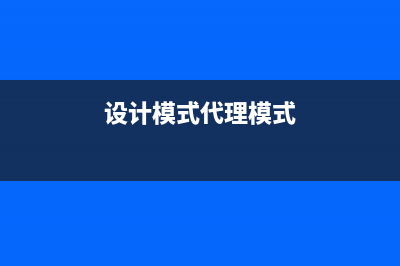位置: IT常识 - 正文
设计模式---代理模式(设计模式代理模式)
编辑:rootadmin推荐整理分享设计模式---代理模式(设计模式代理模式),希望有所帮助,仅作参考,欢迎阅读内容。
文章相关热门搜索词:设计代理完整版,设计模式代理模式的典型例子,设计模式代理模式的典型例子,设计模式代理模式的典型例子,设计模式代理模式的典型例子,设计模式代理模式 迭代器,设计模式代理模式,设计模式代理模式,内容如对您有帮助,希望把文章链接给更多的朋友!
对客户端隐藏目标类,创建代理类拓展目标类,并且对于客户端隐藏功能拓展的细节,使得客户端可以像使用目标类一样使用代理类,面向代理(客户端只与代理类交互)。
话不多说,看一个优化案例。
优化案例最初版v0目前的功能是下载可以下载文件。
public class BiliBiliDownloader { public byte[] download(String filePath) throws InterruptedException { System.out.printf("正在下载BiliBili文件:%s%n", filePath); // 模拟文件下载,睡个10秒 Thread.sleep(10000); return new byte[1024]; // 假装是下载文件的字节数组 }}客户端调用代码,如下。
public class Client { public static void main(String[] args) throws InterruptedException { BiliBiliDownloader bilidownloader = new BiliBiliDownloader(); bilidownloader.download("/root/buzuweiqi/java_manual.txt"); }}下载工具类对客户端完全暴露,客户端可以直接使用下载类实现下载,这实际上是无可厚非的。经过研究发现,这个下载类有一个问题:每次调用都肯定会下载新的文件,即便文件已经被下载过。
为了解决这个问题,开发团队经过商讨已经有了一个初步的方案。看一下代码样例。
修改版v1团队决定使用传统的修改方式(直接修改BiliBiliDownloader),认为这样最为的直观。确实,代码量少且未来可以预期修改不频繁时,传统的修改方案也未尝不是一个好的选择。
public class BiliBiliDownloader { // 定义用来缓存数据的map对象 private static Map<String, byte[]> map = new HashMap<>(); public byte[] download(String filePath) throws InterruptedException { System.out.printf("正在下载BiliBili文件:%s%n", filePath); if (map.containsKey(filePath)) { return map.get(filePath); } // 模拟文件下载,睡个10秒 Thread.sleep(10000); byte[] res = new byte[1024]; // 假装这是下载后的字节数组 map.put(filePath, res); // 加入缓存 return res; }}客户端调用代码,还是和原来一样。
public class Client { public static void main(String[] args) throws IOException, InterruptedException { BiliBiliDownloader downloader = new BiliBiliDownloader(); downloader.download("/root/home/buzuweiqi/java_manual.txt"); // 由于文件已经缓存,所以这次下载非常快 downloader.download("/root/home/buzuweiqi/java_manual.txt"); // 由于文件还未缓存,所以这次下载比较缓慢 downloader.download("/root/home/buzuweiqi/linux_manual.txt"); }}
到目前为止好像都没有啥不妥的地方。直到有一天,客户提出了新的需求:虽然现在只可以下载bilibili的文件(视频,音频,文章等),以后还想要下载youtube的文件。
为了实现这个需求,以及方便以后同类的需求变更,是时候用上代理模式。
修改版v2代理模式在使用的时候需要顶一个一个顶层接口,并且使得代理类和被代理类都实现这个接口。代理类中需要持有非代理类的一个对象。并且在调用代理类的功能前后可以根据业务需要拓展新的功能。
public interface Downloader { byte[] download(String filePath) throws InterruptedException;}public class BiliBiliDownloader implements Downloader { public byte[] download(String filePath) throws InterruptedException { System.out.printf("正在下载BiliBili文件:%s%n", filePath); // 模拟文件下载,睡个10秒 Thread.sleep(10000); return new byte[1024]; // 假装是下载文件的字节数组 }}public class ProxyBiliBiliDownloader implements Downloader { private static Map<String, byte[]> map = new HashMap<>(); private BiliBiliDownloader downloader = new BiliBiliDownloader(); public byte[] download(String filePath) throws InterruptedException { if (map.containsKey(filePath)) { System.out.printf("正在下载BiliBili文件:%s%n", filePath); return map.get(filePath); } byte[] res = downloader.download(filePath); map.put(filePath, res); return res; }}public class YoutubeDownloader implements Downloader { public byte[] download(String filePath) throws InterruptedException { System.out.printf("正在下载Youtube文件:%s%n", filePath); // 模拟文件下载,睡个10秒 Thread.sleep(10000); return new byte[1024]; // 假装是下载文件的字节数组 }}public class ProxyYoutubeDownloader implements Downloader { private static Map<String, byte[]> map = new HashMap<>(); private BiliBiliDownloader downloader = new BiliBiliDownloader(); public byte[] download(String filePath) throws InterruptedException { if (map.containsKey(filePath)) { System.out.printf("正在下载Youtube文件:%s%n", filePath); return map.get(filePath); } byte[] res = downloader.download(filePath); map.put(filePath, res); return res; }}客户端的使用案例如下。
public class Client { public static void main(String[] args) throws IOException, InterruptedException { Downloader downloader = new ProxyBiliBiliDownloader(); downloader.download("/root/home/buzuweiqi/java_manual.txt"); downloader = new ProxyYoutubeDownloader(); downloader.download("/root/home/buzuweiqi/linux_manual.txt"); }}客户端不再依赖目标类,而是转而依赖代理类。代理模式使得增加相似需求时可以只增加一对实现类(目标类,代理类),而不用修改原本的类,符合开闭原则。
实际上通常我们会使用一个更为简单的方式控制代理对象的创建:反射。
修改版v3高层接口,实现的目标类、代理类依旧不变。
public interface Downloader { byte[] download(String filePath) throws InterruptedException;}public class BiliBiliDownloader implements Downloader { public byte[] download(String filePath) throws InterruptedException { System.out.printf("正在下载BiliBili文件:%s%n", filePath); // 模拟文件下载,睡个10秒 Thread.sleep(10000); return new byte[1024]; // 假装是下载文件的字节数组 }}public class ProxyBiliBiliDownloader implements Downloader { private static Map<String, byte[]> map = new HashMap<>(); private BiliBiliDownloader downloader = new BiliBiliDownloader(); public byte[] download(String filePath) throws InterruptedException { if (map.containsKey(filePath)) { System.out.printf("正在下载BiliBili文件:%s%n", filePath); return map.get(filePath); } byte[] res = downloader.download(filePath); map.put(filePath, res); return res; }}public class YoutubeDownloader implements Downloader { public byte[] download(String filePath) throws InterruptedException { System.out.printf("正在下载Youtube文件:%s%n", filePath); // 模拟文件下载,睡个10秒 Thread.sleep(10000); return new byte[1024]; // 假装是下载文件的字节数组 }}public class ProxyYoutubeDownloader implements Downloader { private static Map<String, byte[]> map = new HashMap<>(); private BiliBiliDownloader downloader = new BiliBiliDownloader(); public byte[] download(String filePath) throws InterruptedException { if (map.containsKey(filePath)) { System.out.printf("正在下载Youtube文件:%s%n", filePath); return map.get(filePath); } byte[] res = downloader.download(filePath); map.put(filePath, res); return res; }}在客户端调用时,引入Java反射,通过反射创建具体的代理对象。在config.prop文件中定义PROXY_NAME变量并指定需要反射创建的类的完整路径。
public class Client { public static void main(String[] args) throws Exception { Properties prop = new Properties(); prop.load(new FileReader("src/resource/props/config.prop")); Downloader downloader = (Downloader) Class.forName(prop.getProperty("PROXY_NAME")) .getDeclaredConstructor().newInstance(); downloader.download("/root/home/buzuweiqi/java_manual.txt"); downloader = new ProxyYoutubeDownloader(); downloader.download("/root/home/buzuweiqi/linux_manual.txt"); }}通过Java反射机制,应对每次的需求变更,甚至都不需要修改客户端代码,只需要修改案例中的config.prop即可。减少了不必要的代码修改,提高了系统的可维护性。
总结优点代理类与目标类的使用方式一致,这极大的降低了客户端调用的学习成本,易用性高。
面向接口,无需在意实现的细节。
缺点类的数量倍增,系统复杂度增加。适用场景当需要对于模块拓展,但又不方便打破客户端原有的调用规则时。客户端中对象的创建依旧需要修改,这没有什么好的办法。常用的代理模式使用方案缓冲代理(案例)远程代理虚拟代理除此之外还有很多应用场景,代理模式是设计模式中使用非常广泛的一种。
上一篇:自定义映射resultMap(映射器可以定义参数类型)























